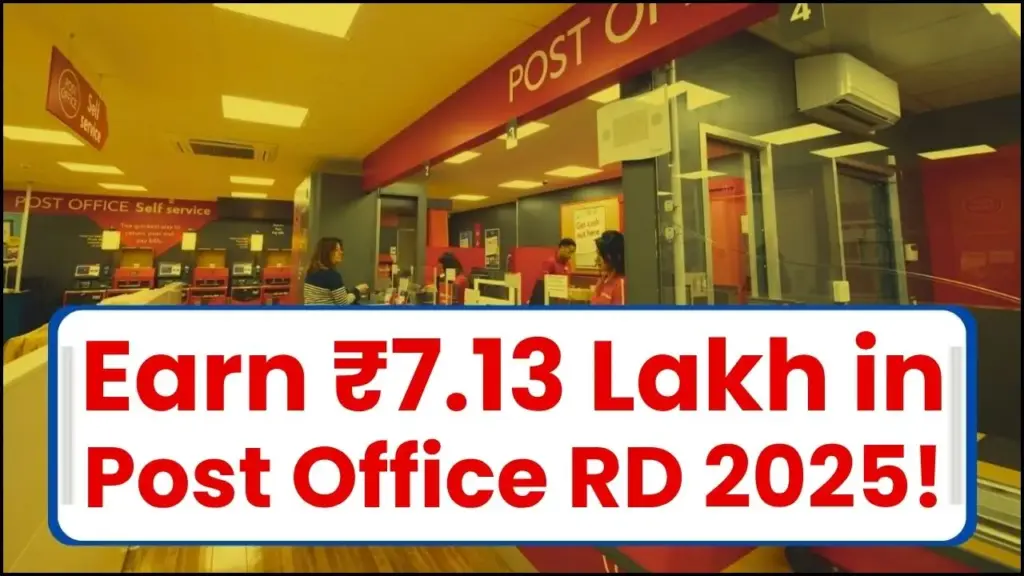If you want steady, guaranteed growth without market swings, the Post Office RD 2025 is a straightforward way to get there. With disciplined monthly savings of ₹10,000, the corpus can realistically aim near ₹7.13 lakh in three years under standard RD math and quarterly compounding. For the October–December 2025 quarter, the notified RD rate is 6.7% per annum (compounded quarterly) for new accounts opened in that window, which gives savers clear visibility while planning short to medium‑term goals.

The Post Office RD 3-year calculation works because every monthly installment earns interest for the remaining quarters until maturity. Earlier deposits compound longer, so they contribute more to the final amount than later ones. Using common RD calculator logic with quarterly compounding, ₹10,000 per month for 36 months aligns with an indicative maturity close to ₹7.13 lakh, subject to the exact opening rate, value-date method, and rounding conventions applied.
Post Office RD 2025
| Item | Details |
|---|---|
| Scheme Name | Post Office Recurring Deposit (National Savings RD) |
| Current Rate (Oct–Dec 2025) | 6.7% per annum, compounded quarterly |
| Standard Tenure | 5 years (premature closure permitted after 3 years with savings rate interest) |
| Example Plan | ₹10,000 monthly for 3 years (36 installments) |
| Indicative 3-Year Target | ≈ ₹7.13 lakh under RD calculator conventions and quarterly compounding |
| Loan Facility | Up to 50% of balance after 12 deposits; interest = RD rate + 2% |
| Premature Closure | Allowed after 3 years; interest recalculated at Savings Account rate |
| Rate Revision | Reviewed quarterly for new openings |
What Is Post Office RD?
The Post Office Recurring Deposit is a government-backed small savings scheme that allows monthly deposits starting as low as ₹100 with no specified upper limit. It offers a fixed, notified interest rate with quarterly compounding, making outcomes predictable. Features include nomination, transfer across CBS post offices, and a loan facility after maintaining regular deposits for a year ideal for savers who prefer certainty over volatility.
Current Interest Rate And What It Means
For October–December 2025, the Post Office RD interest rate is 6.7% per annum with quarterly compounding for new accounts, unchanged from the prior quarter. Rates are reviewed quarterly and apply prospectively: once you open an RD, your rate remains locked for its term. That stability helps align monthly cash flows with clear targets, especially for short and medium‑term goals.
How The 3-Year ₹10,000 Plan Grows
An RD’s maturity equals the sum of the future values of each monthly deposit under quarterly compounding. Each installment accrues interest for the remaining quarters; therefore, deposits made earlier enjoy a longer runway. At common parameters, ₹10,000 x 36 months maps to an outcome close to ₹7.13 lakh, though the precise figure varies with the contracted rate at opening and the computation rules used by the post office.
RD Formula, Simply Put
Calculators adapt the compound interest framework to recurring flows by summing the growth of each monthly installment: A running idea is to apply a quarterly compounding factor to each deposit across the remaining quarters in the tenure. Think of it this way—money invested earlier gets more compounding periods, so staying consistent across all 36 deposits is what brings you closest to the target.
Why A 3-Year Target Works (And Caveats)
While the canonical Post Office RD is a 5‑year product, the three‑year mark matters because premature closure becomes permissible then. However, if you close early, the entire period’s interest is recalculated at the lower Savings Account rate, not the RD rate. If your true objective is three years, plan for that horizon explicitly; otherwise, consider running the full five years to preserve the RD rate and maximize compounding.
Loan Against RD: Liquidity Without Breaking
After 12 successful deposits, you can borrow up to 50% of the RD balance at an interest rate set at 2% above the RD rate. Repayment can be done via EMIs or in a lump sum before maturity. If not cleared by maturity, the loan and interest get adjusted from the proceeds. This option can handle short‑term liquidity needs without sacrificing compounding through premature closure.
Premature Closure: Rules To Know
Premature closure is allowed only after three years from the date of opening. If exercised, interest for the entire period is reset to the Post Office Savings Account rate, which is typically lower than the RD rate. Even a closure a day before maturity is considered premature, and advance deposits restrict closure during the prepaid span. Plan the tenure realistically to avoid an avoidable hit to returns.
Quarterly Compounding Edge
Quarterly compounding means interest is credited every quarter and then itself earns interest. Over multi‑year horizons, that cadence produces a meaningful gap between total deposits and the final maturity value. This is one reason RD outcomes are stronger than simple interest tallies on the same monthly cash flows.
Who Should Consider This Plan
The ₹10,000‑per‑month, 3‑year blueprint suits salaried professionals, freelancers, and small business owners who want sovereign‑backed certainty and a clear corpus target. It’s also effective for parents planning near‑term education costs or households building an emergency fund—especially with the loan‑against‑RD feature as a buffer against breaking the account.
Practical Tips To Reach ₹7.13 Lakh
- Open the RD in a quarter when the posted rate is acceptable; for Oct–Dec 2025, it’s 6.7% and locks in for new accounts opened in that window.
- Automate deposits from a Post Office Savings Account to avoid misses and ensure each installment enjoys full compounding periods.
- If a cash crunch is likely, plan to use the loan facility after 12 deposits instead of premature closure, which would reset interest to the savings rate.
- Keep the passbook/statement updated and track dues; consistency is what closes the gap between principal and the target corpus.
Taxes And TDS Basics
Interest from a Post Office RD is taxable as “Income from Other Sources” as per your slab. TDS can apply based on thresholds and PAN status, so maintain updated KYC and consider tax‑efficient instruments alongside RD for overall optimization. RD isn’t EEE like PPF, so pairing them can balance medium‑term certainty with long‑term tax efficiency.
Step-By-Step: Start A ₹10,000 RD
- Check the live quarter’s RD rate; for Oct–Dec 2025, it’s 6.7% with quarterly compounding for new openings.
- Fix tenure and goal: if the genuine horizon is three years, understand closure rules or plan liquidity via loan to preserve RD‑rate compounding.
- Open at a CBS post office with KYC, set ₹10,000 as the monthly deposit, enable auto‑debit, and add a nominee for continuity.
- After 12 successful deposits, you’re eligible for up to a 50% loan at RD rate + 2%—use it as a safety valve instead of breaking the account.
Comparing To Full 5-Year RD
If your true goal is five years, let the RD run to maturity to retain the RD rate and maximize compounding—the scheme’s default design. If your real target is 36 months, align deposits, liquidity, and closure strategy from day one to avoid savings‑rate treatment and ensure results are close to the ₹7.13 lakh target.
Common Mistakes To Avoid
- Opening a 5‑year RD and breaking it at three years, which resets the entire period’s interest to the Savings Account rate.
- Missing monthly installments, which shortens the compounding runway for later deposits and may attract penalties.
- Ignoring the loan facility after 12 deposits, which is often a better emergency valve than premature closure.
Why The ₹7.13 Lakh Target Is Credible
For ₹10,000 x 36 months, widely used RD calculators employing quarterly compounding produce maturity outputs in the same neighborhood as ₹7.13 lakh at contemporary rates. Final numbers depend on the contracted rate at opening and computation specifics, but the target is a practical planning anchor for current conditions.
Key Features At A Glance
- Government‑backed safety, fixed rate, and quarterly compounding for predictable, low‑risk growth.
- Low entry threshold (₹100) and flexibility to scale contributions as income grows.
- Liquidity through loan after 12 deposits; premature closure allowed after three years with Savings Account interest treatment.
FAQs on Post Office RD 2025
What is the current Post Office RD interest rate?
It’s 6.7% per annum for October–December 2025 for new accounts, compounded quarterly.
Can an RD be closed in three years?
Yes, but it is treated as premature closure and the entire period earns the Savings Account rate instead of the RD rate.
Is there a loan against RD?
Yes. After 12 deposits, you can borrow up to 50% of the balance at RD rate + 2%, repayable via EMIs or lump sum.
How accurate is the ₹7.13 lakh estimate for ₹10,000 x 36 months?
It aligns with outcomes from reputable RD calculators using quarterly compounding; the final figure depends on your contracted rate and computation rules.
















